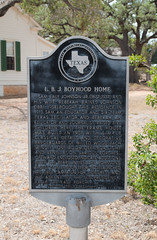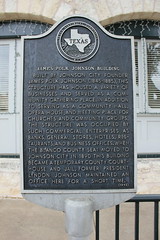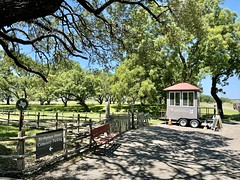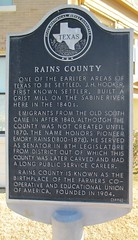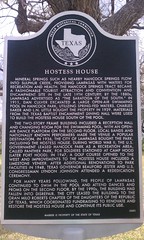Lyndon Baines Johnson


Lyndon Baines Johnson
(1908-1973)
36th President of the United States (1963-1969)
Family tree
friend of Martin Andersen
Commemorated on 17 plaques
Texas Historical Marker #01712
First Christian Church of Johnson City. This congregation was organized in 1903 by the Rev. Tom Smith, an evangelist with the Texas Christian Missionary Society, and twenty-six charter members. Land for a church building was given by Judge N. T. Stubbs and a sanctuary was completed in 1905-06. In its early years the congregation was served by traveling ministers. Among the members was Lyndon B. Johnson, who joined the congregation in 1923 at age fourteen following his baptism in the Pedernales River. The church continues to be an important part of the life of Johnson City. (1989) #1712
?, Johnson City, TX, United States where they member
Texas Historical Marker #02607
Hye Post Office. Named for Hiram ("Hye") Brown, founder of store, in 1880. Post office established 1886. Present store with Bavarian metalwork built in 1904. Owned by Deike family since 1923. At age four, Lyndon B. Johnson, future U.S. President, mailed a letter here- a postal customer for first time in his life. Postmaster General Lawrence F. O'Brien was sworn into cabinet of President Johnson at this post office in 1965. Recorded Texas Historic Landmark, 1966. #2607
?, Hye, TX, United States where they was
Texas Historical Marker #02828
L. B. J. Boyhood Home. Sam Ealy Johnson Jr. (1877-1937) and his wife Rebekah Baines Johnson (1881-1958) bought this residence in 1913. Sam, an educator and six-term Texas legislator, and Rebekah, an educator and journalist, raised five children here. The frame house was built in 1901, with simple Classical details and decorative bargeboards of milled wood. Each wing is one room deep for light and ventilation. Various porches, open and enclosed, indicate additions over the years. In 1937, the Johnson's eldest son, Lyndon (1908-1973), launched his first campaign for Congress, and his ascent to the U.S. presidency, from the east porch. Recorded Texas Historic Landmark - 1965. #2828
?, Johnson City, TX, United States where they lived
Texas Historical Marker #02829
James Polk Johnson Building. Built by Johnson City founder James Polk Johnson (1845-1885), this structure has housed a variety of businesses and served as a community gathering place. In addition to serving as a community hall, opera house, and meeting place for churches and community groups, the structure was occupied by such commercial enterprises as banks, general stores, hotels, restaurants, and business offices. When the Blanco County seat moved to Johnson City in 1890 this building became a temporary county courthouse and jail. Former president Lyndon Johnson maintained an office here for a short time. (1992) #2829
?, Johnson City, TX, United States where they was
Texas Historical Marker #02941
Kincaid Hotel. This four-story hotel building was constructed in 1927 by the family of William Davis "Billy" Kincaid (b. 1854) in memory of his life as a prominent Uvalde cattleman, businessman, and civic leader. The Kincaid Hotel became a popular place for business meetings, banquets, and social gatherings. Ranchers and cattle traders made the Kincaid lobby their meeting place. The hotel has served such noted guests as Texas Governors, Congressional leaders, President Lyndon Johnson, and movie personalities, including Ronald Reagan, later President of the United States. 1981 #2941
North and Getty St., Uvalde, TX, United States where they was
Texas Historical Marker #04577
Santa Fe Depot. Built 1899. Beaux Arts design features native stone banding. When intact, north windows of painted glass depicted travel from Pony Express to steam locomotives. Visitors here have included such world figures as Presidents Franklin D. Roosevelt, Dwight D. Eisenhower and Lyndon B. Johnson. Depot was used by six railroad companies. As of 1970, Santa Fe served Texas with greater trackage than any other railroad, 5102 miles. #4577
1501 Jones, Fort Worth, TX, United States where they visited
Texas Historical Marker #06805
Oath of Office of President Johnson. Near this point on November 22, 1963, Vice-President Lyndon Baines Johnson took the oath of office as 36th President of the United States. He is the first Texan to hold the office of President. The ceremony was held in the central compartment of "Air Force One," the military aircraft assigned to the President. The plane was parked on the concrete ramp at Gate 28, east concourse of this terminal. United States District Judge Sarah T. Hughes, of Dallas, a friend of long standing, was summoned to administer the oath. (Judge Hughes thus became the first woman in history to give the oath of office to a president of the United States. The new Chief Executive, with Mrs. Johnson on his right and Mrs. John F. Kennedy on the left, was sworn into office at 2:38 p.m.In the stresses of the day President Johnson had executive duties thrust upon him immediately during the flight to the Capitol. For over 30 years he had been in public service. Like some of his ancestors (including a university president) he had taught school, as a young man. He had served with distinction in Congress, 1937 to 1949; and in the U.S. Senate, 1949 - 1960, with an unsurpassed record as Senate Majority Leader. #6805
?, Dallas, TX, United States where they was near
Texas Historical Marker #08138
Welhausen School. Designed by Austin architect Charles H. Page, this brick schoolhouse was completed in 1926 and named for County Judge G. A. Welhausen (1862-1944). Twenty-year-old Lyndon B. Johnson came to Cotulla in 1928-29 and served as teacher and principal at the school, which served the city's Hispanic students for many years. Built in a classically inspired plan with a central block flanked by two low wings, the building features decorative tile panels. Recorded Texas Historic Landmark - 1990 #8138
?, Cotulla, TX, United States where they taught
Texas Historical Marker #08640
Lake Somerville. First shovel of earth for Somerville Dam was turned Sept. 22, 1962, by Lyndon Johnson, then vice president of United States. Dam was built to control flooding on Yegua Creek. In the 46 years prior to 1958, Yegua has flooded 43 times, costing lives, crops. Project was finished 1967. #8640
?, Somerville, TX, United States where they was
Texas Historical Marker #09443
Lake Lyndon B. Johnson. This lake, originally Granite Shoals, was renamed for the President of the United States on April 22, 1965, by the Board of Directors, Lower Colorado River Authority (LCRA); in gratitude for his work as U. S. Congressman and Senator toward the development of the project. Mr. Johnson devoted much time and skill to the completion of LCRA programs creating flood control, water conservation and low cost electric power for the people of the Highland Lakes country. A native of this hill country, Mr. Johnson maintains a home on the lake and uses it often as a place for relaxation and the entertainment of guests. It is near his ranch and boyhood home. The body of water impounded by the Alvin J. Wirtz Dam has 6,200 surface acres and 138,000 acre-feet. Construction was begun on the dam in 1949 and since its completion the lake has primarily been a source of hydroelectric energy from the overflow of Lake Buchanan to the north. It is also one of Texas' most outstanding boating and fishing areas. This lake, some 20 miles long, is one of seven in the LCRA which extend 100 miles up the Colorado from Austin. Together they form the largest hydroelectric system in the state. #9443
?, Kingsland, TX, United States where they is commemorated
Texas Historical Marker #10062
Lyndon Baines Johnson. The 36th President of the United States was born here on August 27, 1908; son of a state legislator (1905-1917), Sam Ealy Johnson, Jr., and Rebekah Baines Johnson, a teacher. The house was built in 1906 with the help of neighbors. The Johnsons and Bainesses - early settlers - were ministers, Indian fighters, newspapermen, college professors, ranchers. Original house burned, and was rebuilt by the President. Recorded Texas Historic Landmark - 1967 #10062
?, Stonewall, TX, United States where they was born (1908)
Texas Historical Marker #10063
Lyndon Baines Johnson. The 36th President of the United States of America As a 12-year-old student attended classes of the 8th grade here at the old Stonewall school from October 1920 to June 1921. #10063
?, Stonewall, TX, United States where they attended school
Texas Historical Marker #10283
Beverly Hutchison House. Designed by German architect Charles S. Sinz; built 1896 for the Beverly Hutchison family; later owned by L. Robertson, E. O. Bethke, R. e. Miller and M. Falls, this house in the late 1920s earned its place in history as residence of a student from the Texas Hill County. The young man, Lyndon Baines Johnson, destined to be the thirty-sixth president of the United States, lived in this home during part of his time at Southwest texas State Teacher's College (now Southwest Texas State College). Recorded Texas Historic Landmark - 1968 #10283
400 LBJ, San Marcos, TX, United States where they lived
Texas Historical Marker #10326
Sanders-Grosgebauer House. Built on historic San Antonio Street (originally the stagecoach road to San Antonio) by S. H. and Annie Sanders about 1913, this house was subsequently purchased by Albert N. and Rosa Grosgebauer in 1919. Lyndon B. Johnson was frequently a dinner guest here during his stay at the local college. This house represents a good example of an American foursquare design. Although a common house design in the early 1900s, it was rarely used by San Marcos homebuilders. Recorded Texas Historic Landmark - 1992 #10326
827 W. San Antonio, San Marcos, TX, United States where they was
Texas Historical Marker #12491
Marcus House. After dismissing Frank Lloyd Wright for his failure to produce a suitable design, Stanley Marcus commissioned Dallas architect Roscoe Dewitt to design this International style residence. Recognized worldwide for his innovations in fashion retailing and a significant patron of modern architecture, Marcus hosted hundreds of dignitaries here, including President Lyndon B. Johnson, Princess Grace of Monaco and global leaders in politics, fashion and the arts. Completed in 1938 and home to the Marcus family until 1994, the house is a notable example of its style in Texas. Recorded Texas Historic Landmark - 2001 #12491
10 Nonesuch Rd., Dallas, TX, United States where they was
Texas Historical Marker #13149
Rains County Courthouse. The community of Emory was once called Springville, part of Wood County. In 1870, the Texas Legislature created Rains County from portions of four other counties. Named for early Texas patriot Emory Rains, the county chose Springville as its center of government, renaming it Emory and choosing an existing public square for the site of the county courthouse. The first courthouse, a temporary log structure, served the county for nearly two years, when a two-room building was constructed. It and all the records housed within it burned in 1879, and the county returned to the log structure until a two-story, red brick courthouse was completed in 1884. It was gutted by fire in 1908, but the steel vault containing county records survived the fire. The Bryan Architectural Company of St. Louis, Missouri was selected to design a new courthouse, built around the steel vault still in its original location. Crushed brick from the 1884 building was used in the foundation. The Falls City Construction Company of Louisville, Kentucky served as builder, and the new facility opened in 1909. The courthouse exhibits a unique cruciform plan with projecting wings. The exterior is of ginger brick, produced at the Fraser Brick Co. in Ginger (3 mi. East); both the town and brick were named for the distinctive clay color. Designed in the Classical Revival style, the structure features pilasters and pediment-capped entries, as well as a central dome, reportedly not part of the original design. The courthouse square has long served as a social gathering place. Notable speakers on the square have included U.S. Speaker of the House Sam Rayburn and former president Lyndon Johnson. The site of community fairs, festivals, celebrations and parades, the square continues to be a focal point for Emory and Rains County. Recorded Texas Historic Landmark - 2002 #13149
167 Quitman St, Emory, TX, United States where they spoke
Hostess House. Mineral springs such as nearby Hancock Springs flow into Sulphur Creek, providing Lampasas with waters for recreation and health. The Hancock Springs tract became a fashionable tourist attraction and convention and encampment site in the late 19th century; by the 1880s, Lampasas advertised as “The Saratoga of the South.” In 1911, Dan Culver excavated a large open-air swimming pool in Hancock Park, utilizing spring-fed waters. Charles Baker and L. N. Little bought the property in 1929. Materials from the Texas Baptist Encampment dining hall were used to build the Hostess House south of the pool. The two-story frame building included a reception hall and changing room for the swimming pool, with an open-air dance platform on the second floor. Local bands and nationally known performers made the venue a popular destination. In 1936, the city of Lampasas bought the park, including the Hostess House. During World War II, the U.S. government leased Hancock Park as a recreation area, called Panther Park, for soldiers stationed at Camp Hood (later Fort Hood). In 1947, a golf course opened to the west and improvements to the Hostess House included a limestone veneer. After additional renovations to park facilities in 1948, Texas Governor Beauford Jester and U.S. Congressman Lyndon Johnson attended a rededication ceremony. For many years following, the people of Lampasas continued to swim in the pool and attend dances and proms on the second floor. By the 1990s, the building had fallen into disrepair. The city leased the building to the Oran Milo Roberts chapter of the Daughters of the Republic of Texas, which coordinated fundraising to renovate and restore the Hostess House and continue its public use.
1600 South Highway 281, Lampasas, TX, United States where they was


